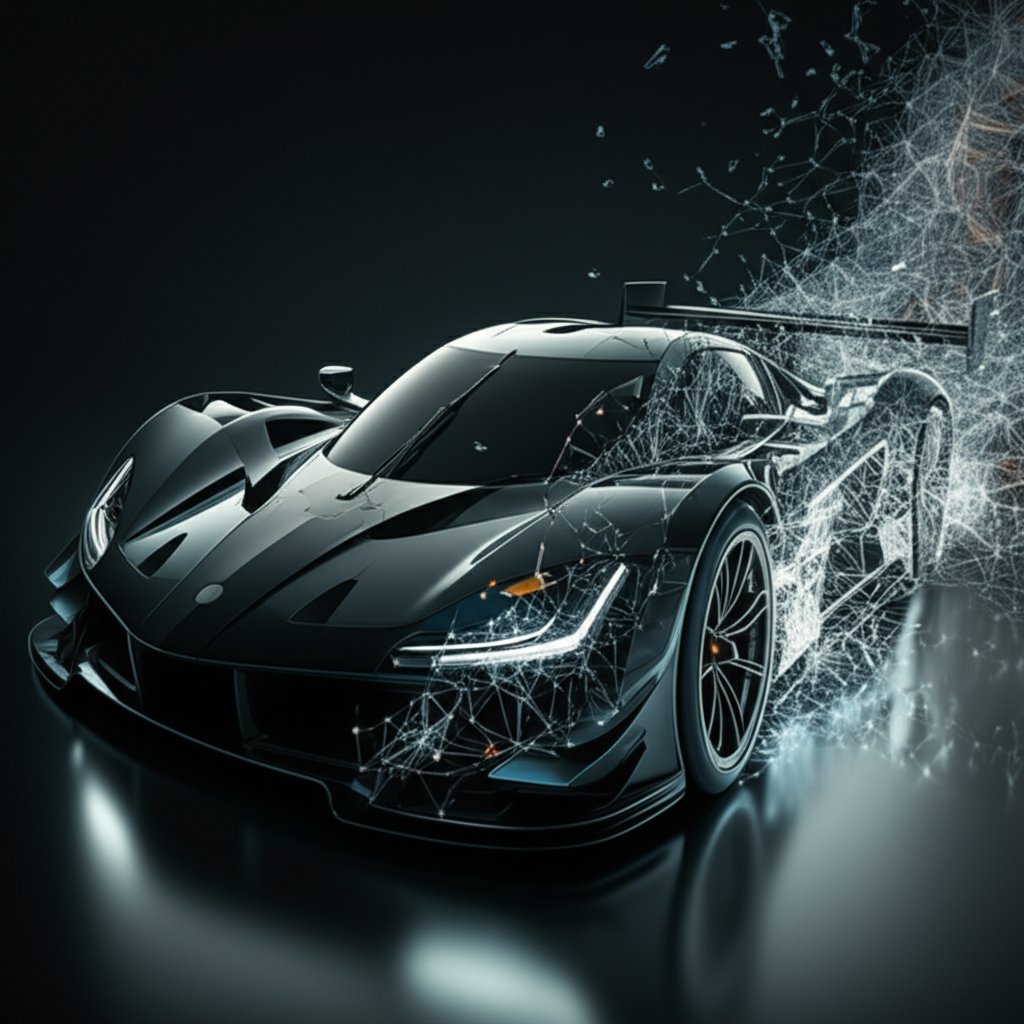The Winning Edge: Advanced Aluminum Alloys in Motorsport

TL;DR
Motorsport engineering relies heavily on advanced aluminum alloys, particularly the 2000, 6000, and 7000 series, for their exceptional strength-to-weight ratio. This critical property allows for the construction of vehicles that are not only lighter and faster but also structurally robust and safe. These specialized alloys are engineered to withstand the extreme forces, temperatures, and vibrations inherent in racing, making them fundamental to achieving a competitive edge on the track.
Key Aluminum Alloys in Motorsport: A Technical Breakdown
The intense demands of motorsport necessitate materials that offer a precise balance of low weight, high strength, and durability. While many materials are used, specific series of wrought aluminum alloys have become indispensable for their engineered properties. Fabricators and race teams select alloys based on the specific requirements of each component, from chassis elements to engine parts. The most prominent choices come from the 2000, 6000, and 7000 series, each offering a unique profile of characteristics derived from its primary alloying elements.
2000 Series: The High-Strength Performer
The 2000 series alloys, with copper as their principal alloying element, are renowned for their impressive strength and excellent fatigue resistance. Alloy 2024, a prime example, is a heat-treatable material widely used for components subjected to high stress and cyclic loading, such as chassis skins and structural spars. The addition of copper allows the alloy to be strengthened significantly through heat treatment, achieving tensile strengths that rival some steels at a fraction of the weight. However, this high strength comes with trade-offs; 2000 series alloys generally exhibit limited formability and are not considered weldable, which often restricts their use to bolted or riveted assemblies and machined parts.
6000 Series: The Versatile Workhorse
Alloy 6061 is arguably the most versatile and widely used heat-treatable aluminum in motorsport fabrication. Its primary alloying elements are magnesium and silicon, which give it a well-rounded profile of good strength, excellent corrosion resistance, and superior weldability and formability, especially in its annealed (O-temper) state. This versatility makes 6061 an ideal choice for a wide range of applications, including intake manifolds, intercooler plumbing, brackets, and structural frames that require complex shapes and welded joints. Its balance of properties and cost-effectiveness makes it a favorite among fabricators for custom parts where both performance and manufacturability are key.
7000 Series: The Apex of Strength
When maximum strength and stiffness are non-negotiable, engineers turn to the 7000 series, with zinc as the primary alloying element. Alloy 7075 is a standout in this category and is recognized as one of the strongest and stiffest commercially available aluminum alloys. Its exceptional strength-to-weight ratio makes it the material of choice for critical, high-load applications like machined suspension components and other straight, non-formed structural parts. Like the 2000 series, 7075 has poor formability and welding characteristics, making it best suited for components manufactured through machining from billet, where its immense strength can be fully leveraged without the need for forming or welding.
| Alloy Series | Primary Alloying Element | Key Characteristics | Common Motorsport Applications |
|---|---|---|---|
| 2000 Series (e.g., 2024) | Copper | High strength, excellent fatigue resistance, not weldable | Chassis skins, spars, flywheels |
| 6000 Series (e.g., 6061) | Magnesium & Silicon | Good strength, highly versatile, weldable, formable | Intake manifolds, intercooler pipes, brackets, frames |
| 7000 Series (e.g., 7075) | Zinc | Highest strength and stiffness, poor weldability/formability | Machined suspension components, high-load structural parts |

Critical Properties for High-Performance Applications
The selection of an aluminum alloy for a motorsport application goes beyond its series number; it's a decision based on a deep understanding of critical material properties. In a sport where performance is measured in milliseconds, every gram of weight and every measure of strength matters. Engineers meticulously evaluate several key characteristics to ensure that each component not only performs under extreme stress but also contributes to the vehicle's overall competitive advantage.
The single most important property is the strength-to-weight ratio. Reducing a vehicle's mass is the most direct way to improve acceleration, braking, and handling. Advanced aluminum alloys offer strength comparable to some steels but at approximately one-third of the weight, providing a significant performance advantage. This allows for the creation of a rigid, safe chassis and robust components without the penalty of excess weight. In Formula 1, for example, aluminum alloys are combined with carbon fiber composites to form the monocoque chassis, creating a structure that is both incredibly light and strong for driver safety and peak performance.
Stiffness and rigidity are also paramount. A stiff chassis resists flexing under cornering and acceleration loads, ensuring that the suspension geometry remains consistent and predictable. This translates to better handling and more efficient power transfer to the track. Alloys like 7075 are chosen for suspension parts precisely because their high stiffness prevents unwanted deflection under heavy loads, maintaining the vehicle's dynamic stability. Achieving these precise properties in finished components often requires specialized manufacturing processes. For automotive projects demanding precision-engineered components, consider custom aluminum extrusions from a trusted partner. Shaoyi Metal Technology offers a comprehensive one-stop service, from rapid prototyping to full-scale production under strict quality systems, specializing in strong, lightweight, and highly customized parts.
Furthermore, heat resistance is crucial for components near the engine and exhaust systems. While aluminum generally has a lower melting point than steel, certain alloys are engineered to maintain their mechanical properties at elevated temperatures. Aluminum is frequently used for heat shielding due to its reflective properties, protecting sensitive components from radiant heat. Engine components like pistons and cylinder heads are often made from specialized cast aluminum alloys designed to withstand the intense heat and pressures of combustion. This excellent thermal conductivity also helps dissipate heat more effectively, contributing to better engine cooling and reliability.
Emerging Trends: The Future of Aluminum in Motorsport
The drive for performance in motorsport is relentless, and material science is a key battleground for innovation. While traditional aluminum alloys remain foundational, the future lies in advanced manufacturing techniques and the development of next-generation materials. These emerging trends promise to unlock new levels of performance by enabling the creation of components that are lighter, stronger, and more complex than ever before.
One of the most transformative technologies is additive manufacturing (AM), commonly known as 3D printing. AM allows engineers to design and produce highly intricate parts with optimized internal structures, such as honeycomb or lattice patterns, that are impossible to create with traditional machining or casting. This capability enables radical weight reduction without compromising strength. Specialized aluminum alloy powders are being developed specifically for AM processes, offering high strength at both room and elevated temperatures. This technology is already being used to create complex components like gearbox casings, suspension uprights, and custom brackets, pushing the boundaries of lightweight design.
Alongside AM, there is ongoing research into the development of new aluminum alloys. Metallurgists are creating novel compositions that offer superior properties tailored for specific challenges. This includes high-temperature aluminum alloys designed to withstand the increasing heat generated by modern hybrid powertrains and downsized engines. Other areas of development focus on alloys with enhanced corrosion resistance for greater durability or even higher strength-to-weight ratios that push beyond the limits of the current 7000 series. These next-generation materials will be critical in meeting the evolving demands of motorsport, where every incremental gain in material performance can translate into a victory on the track.

The Unceasing Pursuit of Performance
From the earliest days of racing, advanced aluminum alloys have been integral to the quest for speed, safety, and reliability. The strategic application of the 2000, 6000, and 7000 series allows engineers to tailor material selection to the unique demands of each component, balancing the critical trade-offs between strength, weight, formability, and cost. These materials form the metallic backbone of modern race cars, enabling the incredible performance seen on tracks around the world.
As the industry moves forward, the synergy between material science and manufacturing technology will continue to define the competitive landscape. Innovations like additive manufacturing and the development of novel alloys are not just incremental improvements; they represent the next frontier in motorsport engineering. By pushing the limits of what's possible with lightweight metals, teams will continue to find the winning edge, ensuring aluminum's place at the heart of high-performance automotive applications for years to come.
Frequently Asked Questions
1. Why is 7075 aluminum so popular in motorsport?
7075 aluminum is popular in motorsport due to its exceptional strength-to-weight ratio, which is among the highest of all commercially available aluminum alloys. This makes it ideal for critical, high-stress components like suspension parts and machined structural elements where maximum strength and rigidity are required without adding unnecessary weight.
2. Can you weld all high-strength aluminum alloys?
No, not all high-strength aluminum alloys are weldable. Alloys from the 2000 series (like 2024) and 7000 series (like 7075) have poor welding characteristics and are typically joined using mechanical fasteners like bolts or rivets. In contrast, alloys from the 6000 series, such as 6061, are known for their good weldability, making them suitable for fabricated assemblies.
3. What is the main difference between 6061 and 7075 aluminum?
The main difference lies in their balance of properties. 7075 aluminum offers significantly higher strength and stiffness, making it superior for high-load, machined parts. 6061 aluminum, while not as strong, is far more versatile due to its excellent weldability, formability, and corrosion resistance, making it a preferred choice for a wider range of fabricated components and general structural use.
 Small batches, high standards. Our rapid prototyping service makes validation faster and easier —
Small batches, high standards. Our rapid prototyping service makes validation faster and easier — 
